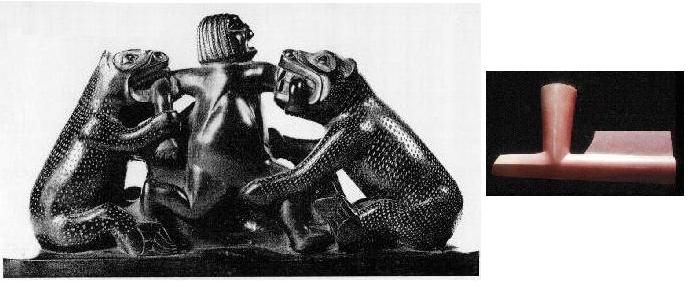( Fr- roche argileuse; Ger- Tonstein;
Nor- leirstein; Rus- ![]() )
)
ARGILLITE (See also SEPTARIUM and SLATE entries.)

A. Argillite. Haida carving (width - ca. 27 cm), which depicts a berry picker being captured by grizzly bears, by Charley Edensaw. Dawson collection of National Museum of Canada (Ottawa, Ontario). (from Barbeau, 1953)
B. Catlinite. Native American peace pipe (length - 22.9 cm). Smithsonian Institution. (© photo by Dick Dietrich)
DESCRIPTION: Argillites are highly compact
sedimentary or slightly metamorphosed rocks that consist largely or
wholly of particles of clay or silt but lack the fissility of shale or
the cleavage characteristic of slate. Some rocks called argillite
would be better characterized as shales with poorly developed
fissility.
Colors - light pink to red (including
brick-red), cream, off-white, and diverse shades of gray
H. (i.e., effective hardness) variable 3 - 7
S.G. 2.56 - 2.68
Light transmission - opaque
Luster - waxy to dull
Breakage - irregular
Miscellaneous
- commonly has a claylike odor when breathed
upon.
OTHER NAMES: From a petrographic standpoint, the term argillite includes relatively massive rocks that are composed largely of one or more clay minerals. Some argillite units comprise mappable units that have been given formal stratigraphic unit names (see Appendix B, Glossary). An example is the Elkhorn Ridge Argillite of the Snake River basin of Oregon.
USES: Formerly for carvings, especially of things such as American Indian pipes, flutes, helmets, masks and totems, and even fetishes (resembling, for example, armadillos) -- typically stylized and commonly based on some myth; more recently for souvenirs with American Indian motifs. Drew and Wilson (1980) illustrate several uses including amulets, brooches, candle holders, compotes, containers (e.g., bowls & boxes), figurines, flutes, medalions, pendants, plates, platters and poles (totem-like). Virtually all of the illustrated examples are handsomely decorative, and several have motifs based on Haidan legends. See also, pertinent statements under the REMARKS subheading.
OCCURRENCES: In sedimentary or, more rarely, volcanoclastic sequences, which commonly have undergone low grade metamorphism.
NOTEWORTHY LOCALITIES: Argillite comes from the Latin argilla (clay) plus -ite (for information re this suffix, see OED (1989 ed.) under b. Mineral. ) Catlinite - Pipestone National Monument, Pipestone County, southwestern Minnesota; Minnehaha County, South Dakota; [and] in the vicinities of Del Rio and Jerome, Yavapai County, Arizona; Zebra rock - Kununurra in the Kimberly region of Western Australia; [and] a rock that consists of Precambrian ash falls or possibly varves that roughly resembles zebra rock sporadically in the area around White Top Mountain, Smyth County, Virginia.
REMARKS: Catlinite was named after George Catlin, a 19th century painter of American Indians. Apparently Its early use stemmed from the fact that it is relatively easily carved and polished and, like meerschaum, does not deteriorate when hollowed out and used as a pipe for smoking tobacco. It is said to have been so-used by some American Indians, apparently the Dakota Indians of Minnesota, for peace pipes. Once these pipes became so-to-speak collection pieces, entrepreneurs soon recognized the value of this material and began having it carved into all sorts of things, typicallay with American Indian motifs, that are sold as souvenirs.
Haidite, sometimes called "black jadeite" and
locally referred to as slate, was the rough rock used by native
Americans (the Haidas of the Queen Charlotte Islands of British
Columbia, Canada and Prince of Wales Island of Alaska) for carvings
made during the mid 1800s and more recently for making souvenirs by an
extremely interesting multistep procedure that is described by Danner
(1976). Danner also notes that "Black to dark-gray argillite of
similar properties is carved in central Japan and it may be that some
argillite carvings in British Columbia could have a Japanese origin."
Pipestone, which, as noted above, is a name frequently given to catlinite, is Minnesota's representative among the nearly 200 commemorative "stones," including at least one from each of the 50 states, that are mounted inside the Washington Monument. It is said to have come from near the city, also called Pipestone, in Pipestone County, in southwestern Minnesota.
SIMULANTS:
***Hydrostone - a U.S. Gypsum product that can be molded, worked during setting and/or carved after it has hardened into just about any shape. It is harder than Plaster of Paris, and relatively large amounts of fillers -- which give it diverse colors and textures – can be added. Although it is still used for such things as statuettes, several people now use some of the stronger and more durable variations that have been developed; these are favored especially for pieces that are likely to be exposed to the weather. As an example, Andrew Werby (United Artworks) notes on his website that he uses one "called Fortran MG ... [which] is mixed from gypsum cement, a polymer emulsion, dry melamine resin, and hardener ..." - [lack of clayey odor when breathed upon].
***Porcelain - black and brownish white molded
shapes of porcelain resemble zebra rock carvings. - [Cursory
examination suffices to recognize this simulant.].
***Wood -
some wood carvings have had their surfaces treated to make them
resemble pieces made by Haidas.
REFERENCES: Howell, 1940; Catlinite - the brochure for Pipestone National Monument, Minnesota; and Peterson, 2011; Haidite - Barbeau, 1953 and Drew & Wilson, 1980; Zebra rock - Bracewell, 1991.
R. V. Dietrich © 2015
Last
update: 13 April 2011
web page created by Emmett Mason